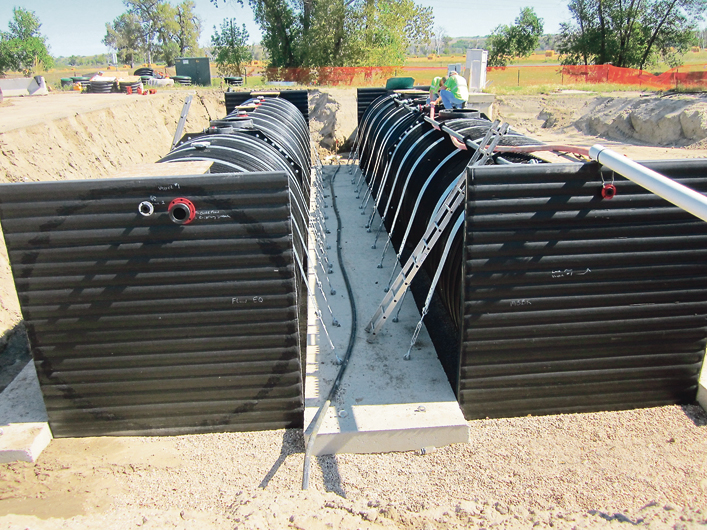Depuporc System Presentation
Published on by Water Network Research, Official research team of The Water Network in Case Studies
Research and development teams from OriginClear and Depuporc meet at a research farm in Aragon, Spain, to discuss future waste-water treatment plans. Because of initial treatment projects, Depuporc has already experienced a 13 percent increase in piglets per sow per year. Animal welfare is the number one method of increasing productivity in Spain. Animals in the boardroom remind researchers of that fact. | OriginClear photo
Concentrated animal feeding operations around the globe are mucking in manure. How can you break manure down into basic benign elements and transport them where they can be useful?
The global population is becoming more affluent and they have a strong hunger for animal protein.
- CAFOs are transitioning from cooler northern and southern climates toward the equator, exacerbating the need for potable water for livestock.
- Eighty percent of all sewage in the world is never treated.
- Thirty-five percent of all clean water is lost in transit.
- Water quality and quantity are diminishing in areas where water is most needed.
- Along the equator, people are dying because they cannot access potable water.
To answer these challenges, water treatment specialists advocate point-of-use decentralized water treatment for CAFOs, food processors, industry and all other water users that need to improve waste-water quality.
Spain’s swine industry is typical of CAFOs. A major Spanish swine waste-water treatment firm called Depuporc recently partnered with a Los Angeles startup called OriginClear, a company that patented two different water treatment technologies.
In a study conducted by California State University (CSU), Bakersfield, startling benefits of cleaner waste water were reported. Using the Depuporc/OriginClear system, piglet births rose from 30 piglets annually per sow to 34 piglets annually per sow, a 13 percent increase in productivity. The dominant factors were an increase in feed regulation and quality, as well as better animal drinking and cleaning water. In addition to improved animal hygiene and disease control, it also reduced water costs through reuse.
The Depuporc parts of the facility, located at the front of the manure flow, are relatively conventional.
However, the OriginClear technology is special because, unlike other systems, it does not require the addition of chemicals. This is a bonus for operators who don’t want the hassles of hazardous materials. It also reduces costs and the environmental impact of injecting oxidants like chlorine or hydrogen peroxide into the process, as required by conventional systems.
By 2016, OriginClear had introduced its breakthrough water cleanup system called electro water separation (EWS). To complement EWS, OriginClear next developed its advanced oxidation process (AOx).
CSU Bakersfield tests show that electro water separation combined with advanced oxidation (EWS:AOx), can also address dissolved contaminants that are difficult to remove without chemicals. You may want to dig out your old high school chemistry text to follow the OriginClear process.
EWS uses electricity in small, programmed doses to gather oils and suspended solids in slurry. Removal of these suspended solids allows for easy mechanical raking off the surface of the water. This ultimately results in the recovery of large quantities of water that can be reused.
Waste water enters the system through continuous tube-shaped inline electro catalytic reactors. These reactors optimize contact between their active components and the water flux. The word flux expresses the rate at which water permeates a reverse osmosis membrane. Typical units of measurement are gallons per sq. foot per day (GSFD).
EWS:AOx technology can also treat dissolved organics that are difficult to remove, such as ammonia, phosphorus and hydrogen sulfide. This stage coagulates suspended solids, oils, grease and non-soluble organics. It breaks the oil emulsion so these elements can be removed in the next stage, which is electro-flotation.
This part of the process can be designed to use donating anodes that directly release ions into the water/contaminants matrix. It can also be designed to operate using non-degrading stable anodes.
This OriginClear subsurface waste-water treatment plant is for a high school that processes 40,000 U.S. gallons per day of waste effluent. The plant produces reusable water for irrigation and sends regulation standard water to municipal facilities in Ridgeview, Virginia. | Dan Early photo
The generation of reactive oxygen species begins here. ROS are highly oxidant molecules such ozone, hydrogen peroxide and hydroxyls. These can degrade virtually any organic contaminant found in water. Being solely composed of oxygen and hydrogen, they also introduce no additional hazardous element in the water.
During electro-flotation, an array of reactors at the bottom of the flotation tank produces gases electrochemically in a controlled manner, resulting in a finely bubbled “cloud.”
This stage separates the suspended coagulated material and completes the process of breaking the oil emulsion initiated in the previous stage. It creates a “mat” of aggregated waste, which it pushes to the surface for mechanical removal. In the case of algae harvesting, this aggregated waste can be a useful resource. ROS continue to be generated here, preparing for the next stage, which is AOx.
OriginClear says its proprietary AOx technology is an evolution of known advanced oxidation processes. AOx is especially suited for fouled water applications. The initial EWS stage by itself has already generated 370 milligrams per second of gas, more than twice the amount needed for the removal of 2,000 mg per litre solids content waste water using electro-flotation. EWS with AOx produced more than 330 grams per cubic metre of mixed ROS, such as hydrogen peroxide.
Attached link
http://www.youtube.com/embed/1LPcG5afN9YMedia
Taxonomy
- Solid Waste Treatment
- Industrial Wastewater Treatment
- Wastewater Treatment
- Hog & Pig Farming
- High Performance Equipment for Waste Water Treatment

